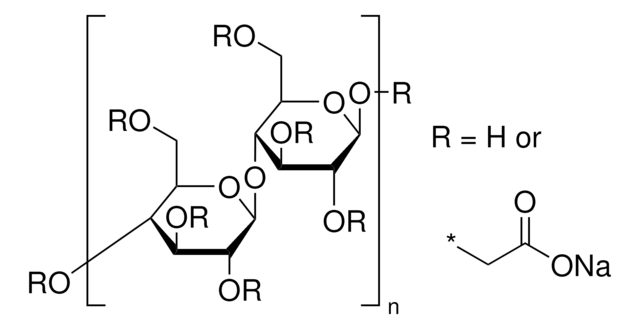C5013
Carboxymethylcellulose sodium salt
High viscosity
Sinónimos:
Sodium carboxymethylcellulose
About This Item
Productos recomendados
origen biológico
wood (pulp)
Nivel de calidad
formulario
powder
color
light yellow
intervalo de pH útil
(20 °C, 10 g/L, 68 °F neutral)
viscosidad
1500-3000 cP, 1 % in H2O(25 °C)(lit.)
mp
> 300.05 °C ((> 572.09 °F ))
solubilidad
H2O: 10 mg/mL
trazas de catión
Na: 6.5-9.5%
temp. de almacenamiento
room temp
InChI
1S/C6H12O6.C2H4O2.Na/c7-1-3(9)5(11)6(12)4(10)2-8;1-2(3)4;/h1,3-6,8-12H,2H2;1H3,(H,3,4);
Clave InChI
DPXJVFZANSGRMM-UHFFFAOYSA-N
¿Está buscando productos similares? Visita Guía de comparación de productos
Descripción general
Aplicación
Nota de preparación
Otras notas
Código de clase de almacenamiento
11 - Combustible Solids
Clase de riesgo para el agua (WGK)
WGK 1
Punto de inflamabilidad (°F)
Not applicable
Punto de inflamabilidad (°C)
Not applicable
Equipo de protección personal
Eyeshields, Gloves, type N95 (US)
Certificados de análisis (COA)
Busque Certificados de análisis (COA) introduciendo el número de lote del producto. Los números de lote se encuentran en la etiqueta del producto después de las palabras «Lot» o «Batch»
¿Ya tiene este producto?
Encuentre la documentación para los productos que ha comprado recientemente en la Biblioteca de documentos.
Los clientes también vieron
Nuestro equipo de científicos tiene experiencia en todas las áreas de investigación: Ciencias de la vida, Ciencia de los materiales, Síntesis química, Cromatografía, Analítica y muchas otras.
Póngase en contacto con el Servicio técnico

